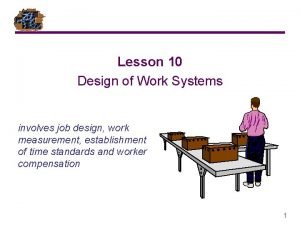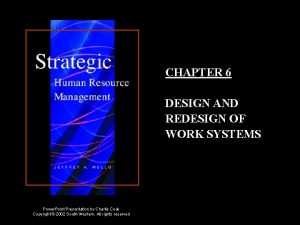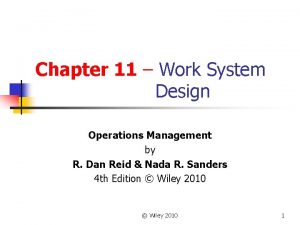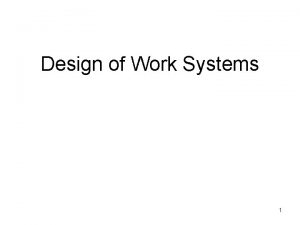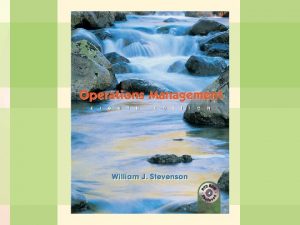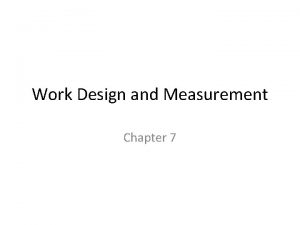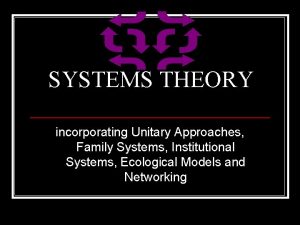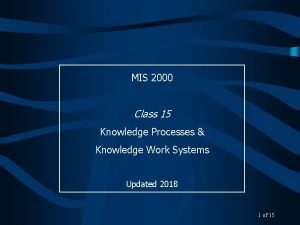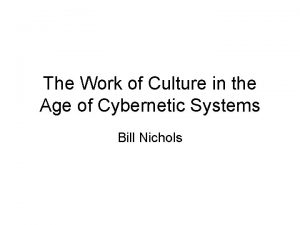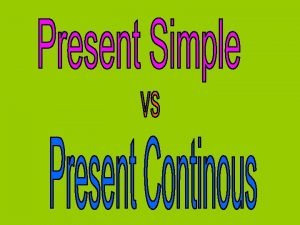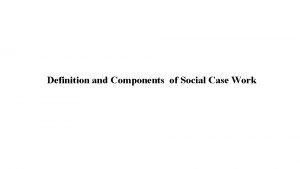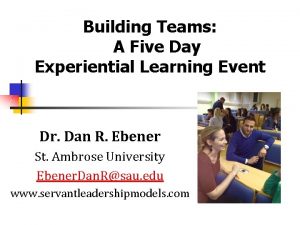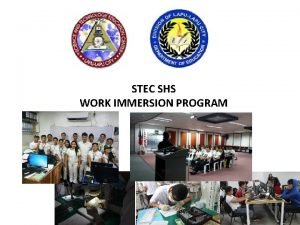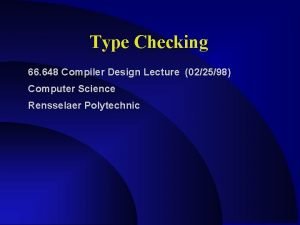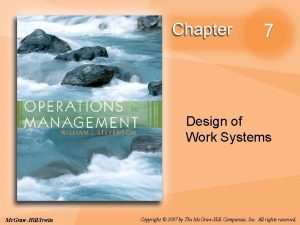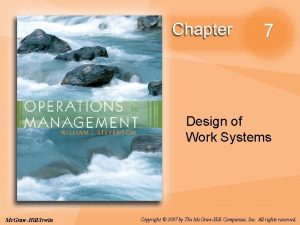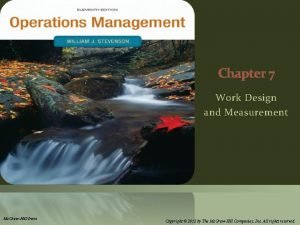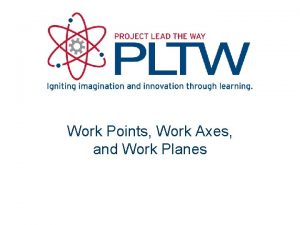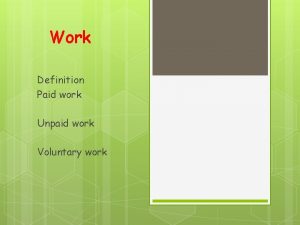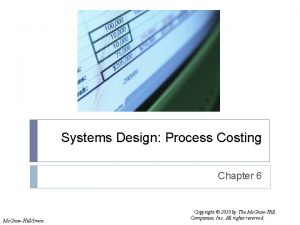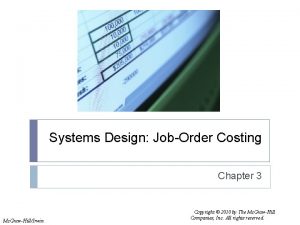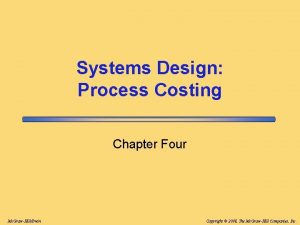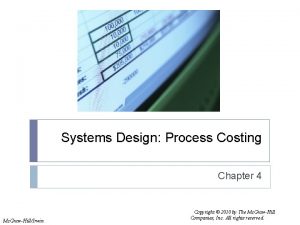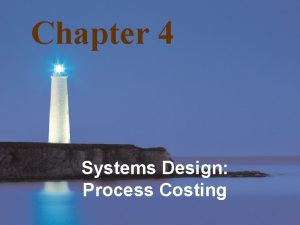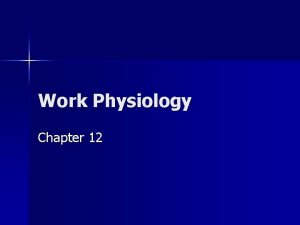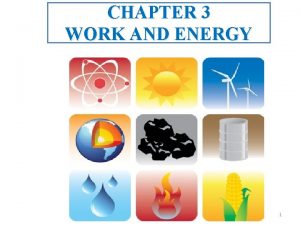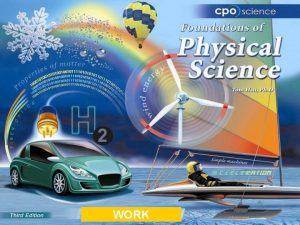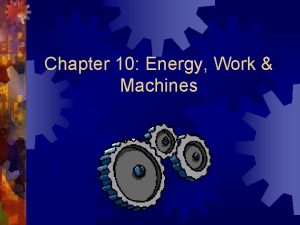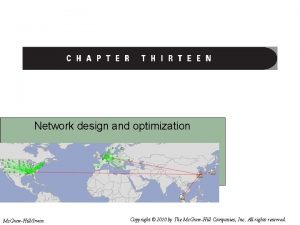Chapter 7 Design of Work Systems Mc GrawHillIrwin






























- Slides: 30

Chapter 7 Design of Work Systems Mc. Graw-Hill/Irwin Copyright © 2012 by The Mc. Graw-Hill Companies, Inc. All rights reserved.

Chapter 7: Learning Objectives ● You should be able to: 1. 2. 3. 4. 5. 6. 7. 8. 9. 10. 11. 12. Explain the importance of work design Compare and contrast the two basic approaches to job design Discuss the advantages and disadvantages of standardization Explain the term knowledge-based pay Explain the purpose of methods analysis and describe how methods studies are performed Compare the four commonly used techniques for motion study Discuss the impact of working conditions on work design Define a standard time Describe and compare time study methods and perform calculations Describe work sampling and perform calculations Compare stopwatch time study and work sampling Contrast time and output pay systems Instructor Slides 7 -2

Quality of Work Life ● Quality of work life affects not only workers’ overall sense of well-being and contentment, but also their productivity ● Important aspects of quality of work life: ● How a worker gets along with co-workers ● Quality of management ● Working conditions ● Compensation Instructor Slides 7 -3

Occupational Healthcare Working Conditions Temperature & Humidity Illumination Safety Ethical Issues Ventilation Instructor Slides Noise & Vibration Work Time & Work Breaks 7 -4

Compensation ● It is important for organizations to develop suitable compensation plans for their employees ● Compensation approaches ● Time-based systems ● Output-based systems ● Incentive systems ● Knowledge-based systems Instructor Slides 7 -5

Compensation Systems ● Time-based system ● Compensation based on time an employee has worked during the pay period ● Output-based (incentive) system ● Compensation based on amount of output an employee produced during the pay period Instructor Slides 7 -6

Individual and Group Incentive Plans ● Individual incentive plans ● Straight piecework ● Worker’s pay is a direct linear function of his or her output ● Minimum wage legislation has reduced their popularity ● Base rate + bonus ● Worker is guaranteed a base rate, tied to an output standard, that serves as a minimum ● A bonus is paid for output above the standard ● Group incentive plans ● Tend to stress sharing of productivity gains with employees Instructor Slides 7 -7

Knowledge-Based Pay Systems ● Knowledge-based pay ● A pay system used by organizations to reward workers who undergo training that increases their skills ● Three dimensions: ● Horizontal skills ● Reflect the variety of tasks the worker is capable of performing ● Vertical skills ● Reflect the managerial skills the worker is capable of ● Depth skills ● Reflect quality and productivity results Instructor Slides 7 -8

Management Compensation ● Many organizations used to reward managers based on output ● New emphasis is being placed on other factors of performance ● Customer service ● Quality ● Executive pay is increasingly being tied to the success of the company or division for which the executive is responsible Instructor Slides 7 -9

Job Design ● Job design ● The act of specifying the contents and methods of jobs ● What will be done in a job ● Who will do the job ● How the job will be done ● Where the job will be done ● Objectives ● Productivity ● Safety ● Quality of work life MGMT 224 - Zappos Job Design (7: 42) https: //www. youtube. com/watch? v=1 mo. BDg. PHEes Instructor Slides 7 -10

Job Design ● Specialization ● Efficiency vs. Behavioral approaches to job design ● Motivation ● Teams ● Ergonomics Instructor Slides 7 -11

Specialization ● Work that concentrates on some aspect of a product or service Advantages For management: 1. Simplifies training 2. High productivity 3. Low wage costs For employees: 1. Low education and skill requirements 2. Minimum responsibility 3. Little mental effort needed Disadvantages For management: For employees: 1. Difficult to motivate quality 1. Monotonous work 2. Worker dissatisfaction, possibly resulting in 2. Limited opportunities for advancement absenteeism, high turnover, disruptive 3. Little control over work tactics, poor attention to quality 4. Little opportunity for self-fulfillment Instructor Slides 7 -12

Efficiency vs. Behavioral Job Design ● Efficiency School ● Emphasizes a systematic, logical approach to job design ● A refinement of Frederick Winslow Taylor’s scientific management concepts ● Behavioral School ● Emphasizes satisfaction of needs and wants of employees Instructor Slides 7 -13

Behavioral Approaches to Job Design ● Job Enlargement ● Giving a worker a larger portion of the total task by horizontal loading ● Job Rotation ● Workers periodically exchange jobs ● Job Enrichment ● Increasing responsibility for planning and coordination tasks, by vertical loading Instructor Slides 7 -14

Motivation ● Motivation is a key factor in many aspects of work life ● Influences quality and productivity ● Contributes to the work environment ● Trust is an important factor that affects motivation Instructor Slides 7 -15

Teams ● Teams take a variety of forms: ● Short-term team ● Formed to collaborate on a topic or solve a problem ● Long-term teams ● Self-directed teams ● Groups empowered to make certain changes in their work processes Instructor Slides 7 -16

Teams ● Benefits of teams ● Higher quality ● Higher productivity ● Greater worker satisfaction ● Team problems ● Some managers feel threatened ● Conflicts between team members Instructor Slides 7 -17

Ergonomics ● Ergonomics (human factors) ● The scientific discipline concerned with the understanding of interactions among human and other elements of a system ● Three domains of ergonomics ● Physical (repetitive movements, layout, health, safety) ● Cognitive (mental workload, decision making, HCI, and work stress) ● Organizational (communication, teamwork, work design, and telework) Reducing Ergonomics Risks at the Workplace (6: 05) https: //www. youtube. com/watch? v=Z 20 Ksq. Jq. QEI Instructor Slides 7 -18

Methods Analysis ● Analyzing how a job gets done ● It begins with an analysis of the overall operation ● It then moves from general to specific details of the job concentrating on ● Workplace arrangement ● Movement of workers and/or materials Instructor Slides 7 -19

The Need for Methods Analysis ● The need for methods analysis can arise from a variety of sources 1. 2. 3. 4. 5. Changes in tools and equipment Changes in product design or introduction of new products Changes in materials and procedures Government regulations or contractual agreements Accidents or quality problems Instructor Slides 7 -20

Methods Analysis Procedure Identify the operation to be studied, and gather relevant data 2. Discuss the job with the operator and supervisor to get their input 3. Study and document the present methods 4. Analyze the job 5. Propose new methods 6. Install the new methods 7. Follow up implementation to assure improvements have been achieved 1. Instructor Slides 7 -21

Guidelines for Selecting a Job to Study ● Consider jobs that: Have a high labor content 2. Are done frequently 3. Are unsafe, tiring, unpleasant, and/or noisy 4. Are designated as problems 1. ● Quality problems ● Processing bottlenecks ● etc. Instructor Slides 7 -22

Analyzing the Job: Flow Process Charts ● Flow process chart ● Chart used to examine the overall sequence of an operation by focusing on movements of the operator or flow of materials Instructor Slides 7 -23

Analyzing the Job: Worker-Machine Chart ● Worker machine chart ● Chart used to determine portions of a work cycle during which an operator and equipment are busy or idle Instructor Slides 7 -24

Motion Study ● Motion study ● Systematic study of the human motions used to perform an operation ● Motion Study Techniques ● Motion study principles– guidelines for designing motion-efficient work procedures ● Analysis of therbligs– basic elemental motions into which a job can be broken down ● Micromotion study– use of motion pictures and slow motion to study motions that otherwise would be too rapid to analyze ● Charts– activity or process charts, simo charts (simultaneous motions) Instructor Slides 7 -25

Developing Work Methods ● In developing work methods that are motion efficient, the analyst attempts to ● Eliminate unnecessary motions ● Combine activities ● Reduce fatigue ● Improve the arrangement of the workplace ● Improve the design of tools and equipment Instructor Slides 7 -26

Work Measurement ● Work measurement is concerned with how long it should take to complete a job. ● It is not concerned with either job content or how the job is to be completed since these are considered a given when considering work measurement. Instructor Slides 7 -27

Work Measurement ● Standard time ● The amount of time it should take a qualified worker to complete a specified task, working at a sustainable rate, using given methods, tools and equipment, raw material inputs, and workplace arrangement. ● Commonly used work measurement techniques ● Stopwatch time study ● Historical times ● Predetermined data ● Work sampling Instructor Slides 7 -28

Work Measurement Techniques ● Stopwatch Time Study ● Used to develop a time standard based on observations of one worker taken over a number of cycles. ● Standard Elemental Times ● are derived from a firm’s own historical time study data. ● Predetermined time standards ● involve the use of published data on standard elemental times. ● Work sampling ● a technique for estimating the proportion of time that a worker or machine spends on various activities and idle time. Instructor Slides 7 -29

Operations Strategy ● It is important to make design of work systems a key element of strategy: ● People are still at the heart of the business ● Workers can be valuable sources of insight and creativity ● It can be beneficial to focus on quality of work life and instilling pride and respect among workers ● Companies are reaping gains through worker empowerment Instructor Slides 7 -30
 The design of work systems involves
The design of work systems involves Design and redesign of work systems
Design and redesign of work systems Design of work systems in operations management
Design of work systems in operations management Design of work systems
Design of work systems Design of work systems in operations management
Design of work systems in operations management Section 4 review physical science
Section 4 review physical science Work design and measurement
Work design and measurement Decision support systems and intelligent systems
Decision support systems and intelligent systems Dicapine
Dicapine Embedded systems vs cyber physical systems
Embedded systems vs cyber physical systems Engineering elegant systems: theory of systems engineering
Engineering elegant systems: theory of systems engineering Aree seekheo
Aree seekheo Knowledge work systems kws definition
Knowledge work systems kws definition The work of culture in the age of cybernetic systems
The work of culture in the age of cybernetic systems Portfolio in work immersion
Portfolio in work immersion Objective for work immersion
Objective for work immersion Hard work or smart work
Hard work or smart work Work in present continuous
Work in present continuous Reciprocal group model
Reciprocal group model Social casework definition
Social casework definition Work group vs work team
Work group vs work team Physics 03-06 impulse and momentum answer key
Physics 03-06 impulse and momentum answer key I work all night i work all day
I work all night i work all day Smart work vs hard work group discussion
Smart work vs hard work group discussion Compilation of work in work immersion
Compilation of work in work immersion Type expression in compiler design
Type expression in compiler design Systems analysis & design in an age of options
Systems analysis & design in an age of options Gantt chart system analysis and design
Gantt chart system analysis and design Systems analysis and design in a changing world
Systems analysis and design in a changing world System analysis and design in a changing world
System analysis and design in a changing world System analysis and design alan dennis
System analysis and design alan dennis
